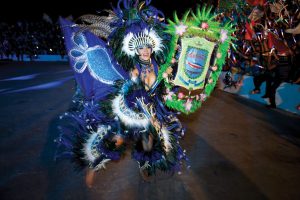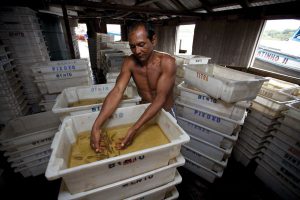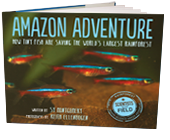(Scientists in the Field Series)
HMH Books for Young Readers, ISBN 978-0544352995
At sunrise, as his riverboat floated up the Rio Negro, flocks of shrieking macaws streaked the sky red and gold. Otherwise, “my full field of vision,” Scott Dowd remembers, “was filled with jungle.” Best of all for the “fish nerd” from Weymouth, Ma., the dark waters beneath his boat teemed with beautiful fish—species he’d kept in aquarium tanks since he was ten.
Now he was headed to the place they’d come from: Barcelos, Brazil, a town of 20,000 in the heart of the Amazon.
But when he got there, he was horrified.

All were bound for exporters supplying home aquaria around the world. The estimated catch of tropical fish leaving the area, Dowd discovered, was 40 MILLION fish per year. “My kneejerk reaction to this was, this was out of control!” Scott said.
But now, 21 years later, he eagerly admits “I could not have been more wrong.” Today a Senior Aquarist with the New England Aquarium in Boston, this charismatic, funny, and articulate researcher is working to promote a project he helped found shortly after that first Amazon expedition.
It’s based on a counter-intuitive premise: that these jungle fishermen are actually protecting the rainforest, nourishing the local economy and promoting animal welfare—all by taking wild fish out of their natural habitats to ship them thousands of miles away.
Every year, Scott has returned to Barcelos with a group of scientists, veterinarians and aquaculture experts to work with local people, check up on the fish, and nurture the project he founded.
Now, to bring their story to the SITF series, Scott has invited Sy and Keith to come along.


How can the area sustain an annual take of 40 million fish? Every year, when the dry season comes and the water level drops, billions of ornamental fish lie doomed in drying puddles. Many species compensate by producing huge numbers of offspring—plenty for fishermen to catch. And lucky are the fish scooped into their nets. In the wild, it’s rare for, say, a cardinal tetra to survive a full year. In captivity, that fish might live two or three.
“I know of no more benign fishery,” says Scott. Most important, without harming the fish they catch,, the industry is helping to save the Amazon—because these lucky little fishes are key to the local economy. Barcelos’ aquarium trade now provides 60 percent of the cash income for 40,000 people who live in an area of 46,000 square miles.
Because of the importance of the home aquarium trade, the fishermen and their families stand fast against environmentally disastrous timber, cattle ranching and mining projects. They know that degrading their rivers would end their livelihoods.
In local parlance, the little fishes are called piaba (say it “pee-AH-bah”)—a synonym for “pipsqueak” or “small fry.” But today, to be a “piabeiro” (as these fishermen are called) is a Big Deal.

But there’s a dark cloud on the horizon, and we’ll write about this, too. Some pet stores are turning to captive breeders in the U.S. and Asia, who use hormones to force their fish to spawn in captivity. That could mean that piabeiros would lose their jobs. Eliminate the piaba payoff, and the local economy, piabeiro culture, and reasons to resist logging and mining will disappear. So Scott’s work with his “Project Piaba” is especially important now.
In this book, we’ll document the science of how Scott and his colleagues check on the health of the captured fishes and the Amazon environment, and how they are working with local people to ensure the fishes are kept healthy on their long journey to aquaria around the world.
It’s a story set in the greatest jungle in the world. The Amazon is full of astonishing creatures, and our pages will be full of them: from the impossibly pink river dolphins to the toothsome piranha, from spiders who spin webs as big as volleyball nets to ants who create gardens underground. And the fishes! The dark, acidic waters of the Rio Negro have sculpted incredible forms, including fish who build bubble nests in trees and fish who fly out of the water to hunt. We will meet them all.

Scott in fact is dreaming of pet stores providing a QR code that can be scanned by the hobbyist, who can then link to a website where he can meet the people who caught his new pet—and see how his purchase is protecting the Amazon. “If it tells the story of helping families protect their environment,” he says Moore, “then that’s a great thing.”

Photos:
The Amazon offers unrivaled opportunity for lush photography—but especially so with a photographer superbly skilled both on land and under water. Our pages will be enlivened with dramatic landscapes, stunning birds and graceful monkeys, huge spiders, radiant butterflies, compelling portraits of scientists and fishermen at work, scenes from thatched-roof villages and colorful cultural events, and underwater shots of spectacularly colored fishes, dolphins and caimans.
Logistics:
We would leave in January 2015, to coincide with the Piaba festival. The expedition would take two weeks, most of which would be spent in Barcelos, Brazil. Except for one night spent in sleeping in hammocks in the forest (thanks to the acidic black water river, mosquitos are few) and our first and last nights in Manaus hotels, we will be living on a river boat—offering total immersion in the Amazon environment.

